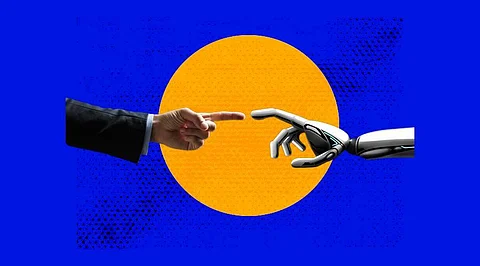

Artificial general intelligence powers intelligent machines to impersonate human tasks. Artificial general intelligence also represents general human cognitive abilities in software faced with an unfamiliar task. In this article, we will have a deep understanding of artificial general intelligence and artificial general intelligence capabilities.
AGI is defined as powerful artificial intelligence (AI). The application of artificial intelligence to specific tasks or problems is referred to as weak or narrow AI. Narrow artificial intelligence is demonstrated by IBM's Watson supercomputer, expert systems, and self-driving cars.
An intelligent system with comprehensive or complete knowledge and cognitive computing capabilities is referred to as AGI in computer science. As of now, there are no true AGI systems; they are the stuff of science fiction. In those terms, the performance of these systems is indistinguishable from that of a human. However, because of its ability to access and process massive data sets at incredible speeds, AGI's broad intellectual capacities would exceed human capacities.
True AGI should be capable of performing human-level tasks and displaying abilities that no existing computer can. AI can now perform a wide range of tasks, but not with the level of success that would qualify them as human or general intelligence.
Background knowledge
Abstract thinking
Common sense
Transfer learning
Cause and effect
Creativity:
An AGI system could theoretically read, improve, and comprehend human-generated code.
Fine motor skills:
This includes an example of taking a set of keys from a pocket which requires some imaginative perception.
Sensory perception:
Color recognition is a subjective type of perception that AGI would excel at. It could also detect depth and three dimensions in static images.
Understanding natural language
Understanding human language is highly dependent on context. AGI systems have the level of intuition required for NLU.
Navigation
A geographic location can be pinpointed using the existing Global Positioning System (GPS). AGI would be able to project movement through physical spaces better than existing systems once fully developed.
Create fixed structures for all tasks
Use different kinds of knowledge
Handle various kinds of learning and learning algorithms
Engage in metacognition and help us with the use of metacognitive knowledge.
Understand belief systems and
Understand symbol systems
AGI should theoretically be able to perform any task that a human can and exhibit varying levels of intelligence. In most areas of intelligence, it should be as good as or better than humans at solving problems.
Poor AI, on the other hand, excels at completing specific tasks or types of problems. Many existing AI systems self-improve and solve specific types of problems by combining machine learning, deep learning, reinforcement learning, and natural language processing. These technologies, however, fall far short of the total capacity of the human brain.
Voice assistance like Alexa and Siri
Customer service chatbots
Marketing platforms used to gather customer sentiment and business intelligence
Recommendation engines such as Netflix, Google and Spotify
Facial recognition applications
Many experts are sceptical that AGI will ever become a reality.
In a 2014 interview with the British Broadcasting Corporation, English theoretical physicist, cosmologist, and author Stephen Hawking warned of the dangers. "The development of full artificial intelligence could mean the extinction of the human race," he warned. "It would take off on its own, redesigning itself at a rapid pace. Humans, hampered by slow biological evolution, would be unable to compete and would be surpassed."
However, some AI experts predict that AGI will continue to evolve. Ray Kurzweil, inventor and futurist, predicted that computers will achieve human-level intelligence by 2029 in an interview at the 2017 South by Southwest Conference.
Kurzweil also predicts that AI will advance at an exponential rate, resulting in breakthroughs that will allow them to operate at levels beyond human comprehension and control. The singularity refers to this point of artificial superintelligence.
Another viewpoint that supports the eventual development of AGI is the Church-Turing thesis, which was developed by Alan Turing and Alonzo Church in 1936. It asserts that any problem can be solved using an algorithm given an infinite amount of time and memory. It is unclear which cognitive science algorithm will be used. Some believe that neural networks hold the most promise, while others believe that a combination of neural networks and rule-based systems holds the most promise.
Neuromorphic computing, which uses artificial neurons and synapses to replicate the biological framework and functioning of the human brain, is another potential initiative from neuroscience.
Join our WhatsApp Channel to get the latest news, exclusives and videos on WhatsApp
_____________
Disclaimer: Analytics Insight does not provide financial advice or guidance. Also note that the cryptocurrencies mentioned/listed on the website could potentially be scams, i.e. designed to induce you to invest financial resources that may be lost forever and not be recoverable once investments are made. You are responsible for conducting your own research (DYOR) before making any investments. Read more here.
